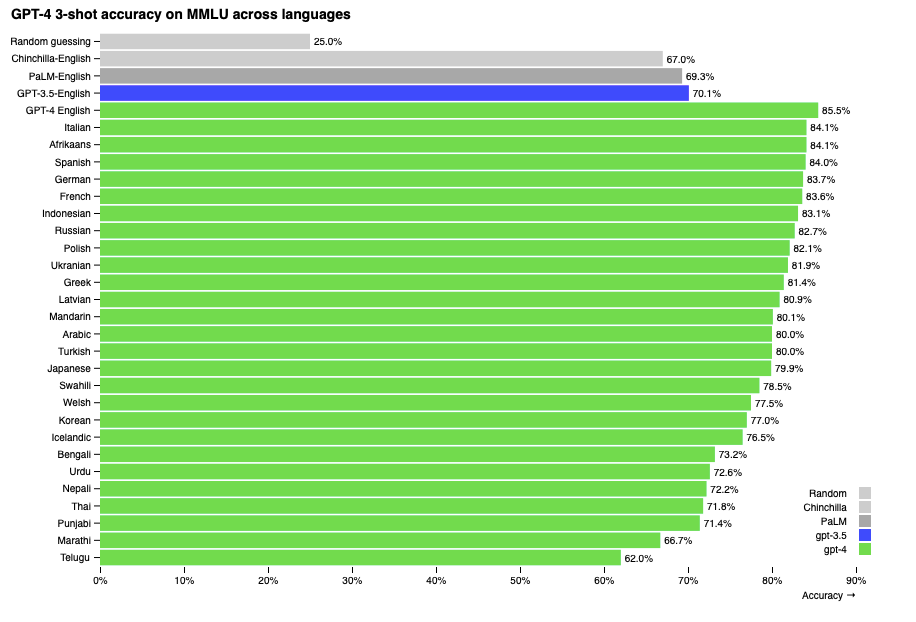As artificial intelligence continues to advance at an incredible pace, language models like ChatGPT-4 are pushing the boundaries of what is possible with natural language processing. ChatGPT-4 is expected to be a significant leap forward in AI language modeling, with the potential to transform the Healthcare industry.

What is ChatGPT-4?
ChatGPT-4 is the latest iteration of OpenAI’s GPT (Generative Pre-trained Transformer) series, which includes GPT-1, GPT-2, GPT-3 (and its update GPT 3.5), and now GPT-4.
The GPT-4 model was trained on a massive amount of text data (100 trillion parameters) to help it understand natural language and generate human-like responses. In addition, this chatbot relies on a large multimodal model, accepting image and text inputs while emitting text outputs.
What can and cannot ChatGPT-4 do?
GPT-4 can process both images and text, unlike its predecessors, which can only process text. This enables GPT-4 to analyze the contents of an image and connect it with a written question, but it cannot generate images.
GPT-4 can process whole scientific papers and novellas in one go, allowing it to answer more complicated questions and connect more details in any query.
GPT-4 measures input and output in "tokens" rather than character or word count, with each token equal to roughly four characters and 75 words generally taking up around 100 tokens.
GPT-4 has performed well on standardized tests such as BAR, LSAT, GRE, and various AP modules, but still struggles with tests that require more creativity.
Incredible steps from ChatGPT-3
Understand images and visual inputs
One of the major improvements of GPT-4 over ChatGPT is the ability to accept visual inputs and understand them.
The previous iteration of ChatGPT, which is based on the GPT-3.5 model, is limited to accepting only textual input, unlike GPT-4, which permits users to include images as prompts. This development is noteworthy because it eliminates the need for tedious and sometimes impossible image description.
More context-focus
ChatGPT has a token processing limit of 4096 tokens, equivalent to roughly 3000 words of text per inquiry, which restricts its ability to analyze or generate extended content. On the other hand, GPT-4 can process up to about 25,000 words of text, allowing it to produce longer written pieces, distill information from dense materials, analyze extensive texts, and sustain more prolonged conversations without losing context.
More reliable and accurate
One of the primary deficiencies of ChatGPT is its tendency to provide incorrect responses with a high level of confidence. In contrast, GPT-4 is purported to be considerably more dependable and less inclined to fabricate or "hallucinate" answers than its previous versions.
According to OpenAI, GPT-4 scores 40% higher than GPT-3.5 on internal adversarial factuality evaluations.

Source: OpenAI
Effective using more languages
ChatGPT has already shown impressive language skills, which is not unexpected considering that it is predominantly a language model. Its proficiency in English is unsurprising since it was trained on data from the internet, which is primarily in English. However, GPT-4 has significantly enhanced its precision compared to GPT-3.5, scoring 85.5% accuracy in language tests compared to 70.1%. Moreover, when tested in 26 languages, GPT-4 surpassed the English language performance of GPT-3.5, which is a significant development.

Source: OpenAI
Big game changer in Healthcare
ChatGPT-4, a next-generation AI language model, has the potential to revolutionize the healthcare industry. Its advanced language processing capabilities, combined with the ability to understand visual inputs, could be used to improve medical imaging analysis, clinical decision-making, patient engagement, and more.
Medical Imaging Analysis
One of the most promising applications of ChatGPT-4 in healthcare is medical imaging analysis. With its ability to understand visual inputs, ChatGPT-4 could be trained on large datasets of medical images to accurately identify and diagnose medical conditions. It could also be used to generate reports summarizing complex imaging data, helping doctors make more informed treatment decisions.
Clinical Decision-Making
ChatGPT-4 could also be used to analyze and interpret vast amounts of medical literature and research data. It could help doctors and researchers stay up-to-date with the latest medical advancements, providing personalized insights and recommendations based on individual patient data.
Patient Engagement
Moreover, ChatGPT-4 could improve patient engagement and satisfaction by providing more personalized and contextually relevant responses to patient inquiries. It could assist with appointment scheduling, medication management, and even telemedicine consultations, improving access to healthcare services and reducing wait times.
ChatGPT-4 in Action
Several organizations are already exploring the potential of ChatGPT-4 in healthcare. For instance, Microsoft has partnered with Prellis Biologics to use the technology to design 3D-printed organs. Another company, Optum, is using ChatGPT-4 to analyze electronic health records to improve patient care.
Watch more at
Bottom up
In conclusion, the application of ChatGPT-4 in healthcare has the potential to revolutionize the way we approach medical diagnosis and treatment. By utilizing natural language processing and machine learning, ChatGPT-4 can quickly analyze vast amounts of medical data and provide accurate and personalized recommendations to healthcare professionals and patients alike. As ChatGPT-4 continues to evolve and improve, we can expect to see it play an increasingly important role in the future of healthcare.

Comments